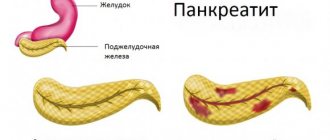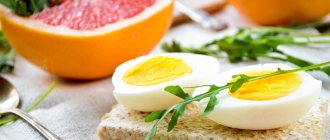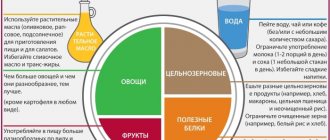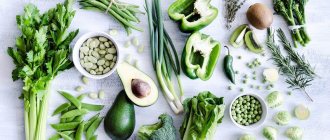What not to eat
You should immediately identify foods that need to be excluded from the diet:
- everything is fatty, smoked, fried, canned, spicy and salty. In particular, you should forget about hot sauces and seasonings. Any varieties of fish or meat falling under this list must be excluded;
- additional acids are undesirable, as they further injure the mucous membrane. Therefore, high acidity dairy products should be ignored;
- fruits, berries and vegetables with coarse fibers or grains will be harmful. These are pepper, cucumber, spinach, radish, blackberry, raspberry, pineapple. Unprocessed lentils, beans, peas, and beans are poorly digested;
- Any alcohol is prohibited for gastritis. Even kvass is undesirable for gastritis. Like grape juice, carbonated drinks, coffee - with this diagnosis they will negatively affect the stomach;
- As for flour, eating with low stomach acidity excludes fresh baked goods and cookies. Whole grain bread and crispbread will also turn out to be roughage. Pancakes and pancakes are also prohibited.
Prohibited Products
Limited:
- spices;
- spicy food;
- whole milk;
- coarser fiber.
Anything that is difficult to digest is prohibited:
- baking;
- fatty meat and fish;
- fried pies;
- legumes;
- corn;
- oats, etc.
Do not irritate the mucous membrane with pickles, smoked meats, spicy foods, garlic, etc. Bloating can be caused by beans, peas, millet, and raw vegetables. The temperature of food and drinks should be moderate.
Recommended food
Now let’s talk about what food with low stomach acidity will not harm:
- bread - despite the ban on most flour products, should be present in the diet for gastritis. But not fresh - preferably a little dried out or completely stale. You can include some non-hot baked goods made from unleavened dough into your diet for gastritis;
- cereals - almost all are allowed, with the exception of pearl barley and millet. Preference should be given to oatmeal, buckwheat, rice, and semolina. Whatever the patient chooses, they should be thoroughly boiled in water;
- broths - both vegetable and meat, fish. When there is no exacerbation, a diet with low stomach acidity allows the consumption of vegetables and meat. As for meat, chicken, beef, turkey are preferred, and for fish - halibut, cod;
- dairy products should be presented in the form of low-fat cottage cheese and milk, kefir, and natural yogurt. High-quality hard cheese is welcome for gastritis;
- Some vegetables increase the acidity of gastric juice without harming the mucous membrane. These are zucchini, carrots, cabbage, tomatoes. Citrus fruits are especially preferred among fruits.
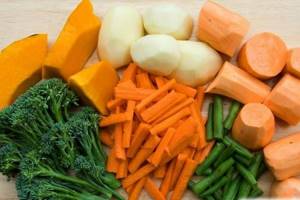
What is harmful
There is a category of food products that can increase the property of gastric juice in question. If you have gastritis of the hyperacid type, they should not be consumed. Pay attention to this list (the table of prohibited foods includes foods that can be consumed every day).
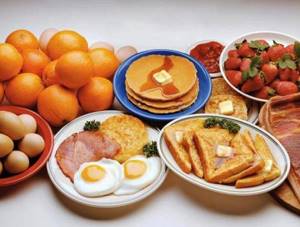
Foods that raise pH
- Sour, smoked, pickled foods.
- Pickles.
- Fried food.
- Sweets.
- Fast food.
- Soda.
- Citrus.
- Strong coffee.
- Dark chocolate.
- Onions, garlic, radishes, radishes.
- Tomatoes.
- Plums.
- Fatty sour cream and cottage cheese.
All this must be abandoned or sharply reduced consumption, because an unhealthy diet with a predominance of these dishes increases the acidity of gastric juice.
Recommended drinks
It is recommended to consume juices, fruit drinks from rose hips, lingonberries, sea buckthorn, and cranberries. Teas are healthy, but not strong. Let's look at them in more detail:
- green – 1 tbsp. l. tea leaves are filled with hot water with a volume of 300 ml. Let it sit for half an hour, after which the mug is placed in hot water and kept on fire for about an hour. After straining, you can drink tea 15 minutes before meals, 2 tbsp. l.;
- anise – 1 tsp. seeds are poured into a thermos and 250 ml is poured. hot water. After 2 or 3 hours, you can strain it and drink ¼ glass before each meal. Relaxes the gastric muscles, fights some bacteria;
- Ivan tea - 60 g of leaves poured into 1 liter. water, boil and be sure to strain. You should drink 150 ml. before eating. This miracle tea relieves inflammation, coats the stomach walls, and effectively normalizes the digestion process;
- Herbal teas are quite useful drinks for gastritis. However, before using them, you should consult a specialist. The fact is that a person may have an individual intolerance to any component.
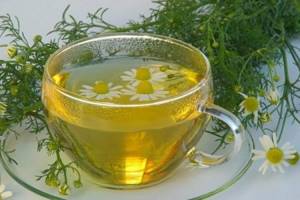
Basic principles of nutrition
A strict, mechanically and chemically gentle diet is one of the important and effective aspects of the treatment of this disease. To normalize digestion, the patient needs not only to give up some familiar foods, but also to radically reconsider his attitude towards nutrition.
To improve the condition, the patient should adhere to the following recommendations:
- Eating should take place in a calm environment. You'll have to forget about snacking on the run.
- Dishes that are recommended for consumption should not only be tasty and healthy, but also look appetizing, because the attractive appearance of food promotes the production of gastric juice.
- Food for patients is steamed, stewed or boiled. Even individual components of dishes cannot be fried.
- It is better to eat as much crushed or even ground food as possible.
- All food and drinks cannot be too hot or cold.
- It is better to eat little by little, but often. Ideally, switch to five meals a day.
- You need to eat slowly, chewing each portion thoroughly.
- Drinking 0.5 glasses of mineral water before meals activates the production of hydrochloric acid.
General recommendations regarding nutrition
A diet for gastritis with low acidity can consist of various dishes. But they will not bring benefits without taking into account the general rules of eating:
- If you have gastritis, you need to eat in small portions, otherwise your stomach will not be able to cope with even the healthiest food. However, in order to avoid feelings of hunger, you are allowed to eat 5 or 6 times daily. At the same time, each piece must be chewed thoroughly, without rushing.
- Even the most useful dish for this disease will cause harm if temperature standards are not met. Cold and hot foods for those suffering from gastric problems should be excluded from the menu.
- A diet for gastritis requires not just a dietary one, but also one that will facilitate the digestion process to the maximum. Purees are great for this - it is recommended to puree the ingredients if possible. Before eating vegetables and fruits, you should eat them, since the fiber they contain is not always well absorbed.
- Many recipes for dishes for patients with gastritis of this type are based on broths. They stimulate the work of gastric juice well, but strong ones irritate the stomach. It is recommended to use secondary broth.
- Vegetables for gastritis should be eaten pureed or in the form of juices. Carrot, cabbage, and tomato are especially useful. But pumpkin and potato suppress acidity even more, so they should be avoided.
Antacid products
Some foods are natural antacids. Among the foods that reduce stomach acidity are the following:
- Milk (especially goat's milk). Drinking milk regularly will help get rid of unpleasant symptoms. It is good for the stomach to consume only natural dairy products.
- Buttermilk. It is obtained during the preparation of butter. Can everyone drink it? It has been proven that it has virtually no contraindications.
- Potato juice. It can quickly reduce the acid content.
- Ginger root (it is advisable to start using it in small quantities, gradually increasing the dose).
- Juice obtained from celery.
- Dried fruits.
Among the foods with low acidity there are many rich in vitamins. They are very useful for gastritis. They quickly reduce stomach acidity.
People's Councils
Some of the most common foods, taken in a special way, can beneficially supplement a diet for gastritis. Here are a few folk recipes that increase the effectiveness of the diet.
Beans, as we mentioned earlier, increase acidity, but are not absorbed well enough in their usual form. It is recommended to boil and puree it. Puree can be used both as an independent product and as an ingredient for making soups and fillings.
Turnips are also extremely healthy, especially if you grate them well. By watering the processed vegetable with vegetable oil, you can get a pleasant addition to your diet. It is used three times daily.
Walnut tincture is also taken three times a day. You will need 10-15 unripe nuts, which are filled with half a liter of vodka. After 2 weeks in a glass container at room temperature, the product is ready for use. A tablespoon of it must first be dissolved in a glass of water.
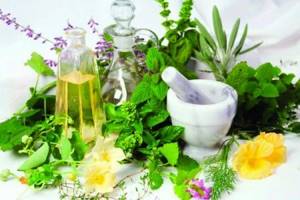
Plantain is another component that increases acidity for gastritis. The leaves can be cut into a salad, or you can squeeze the juice out of them. If you choose juice, take it 10 minutes before meals, one tablespoon at a time.
It’s not forbidden to try many favorite preparations for the winter, but there are nuances. So, it is recommended to use oxalic acid instead of vinegar. In other words, sorrel just needs to be added to the marinade.
Effective diet for gastritis with low acidity, therapeutic diet No. 2
Diet No. 2 is one of the treatment tables developed under the guidance of Professor M.I. Pevzner. According to the doctors we interviewed, nothing better than Pevzner’s treatment tables has yet been invented.
The diet is balanced and complete. The energy value of the diet is 2900 kcal. When using a diet for gastritis, you need to consume increased doses of vitamins. The specific amount should be prescribed by your doctor.
In case of a sluggish process of restoring gastric function with reduced secretion, rather sharp “transitions” from a gentle to a loading diet are recommended, which also stimulates the functioning of the gastrointestinal tract, but such “transitions” are possible only as prescribed by the attending physician.
More precise quantities are calculated individually, based on the patient’s needs. Food can be boiled, stewed, baked in the oven, grilled, and lightly fried (without forming a crust and without breading).
Diet No. 2 is one of the treatment tables developed under the guidance of Professor M.I. Pevzner
For the first 1–2 weeks, food should be crushed or the dishes should be prepared with an initially puree-like consistency. Meat, fish and vegetable broths, lightly salted herring are allowed - they help stimulate the gastrointestinal tract. 4-5 meals a day, in small portions. Food should be warm (40–50 degrees) so as not to injure the mucous membrane of the gastrointestinal tract.
If there are problems with stool, fresh juices are introduced into the diet. For diarrhea - pomegranate, quince, pear, blackcurrant. For constipation - carrot, apricot, plum juices. Beet and carrot salads, curdled milk, yogurt and fresh kefir.
In the daily diet:
- proteins – 100 grams (of which 60% are animal);
- fats – 70–80 grams (20–25% vegetable);
- carbohydrates – 280–400 grams (depending on lifestyle);
- salt – 10 g, water – 1.5 liters.
Diet for the stomach and raw food diet
A raw food diet is often perceived as a way to eat properly and eliminate many health problems. However, are raw food diet and gastritis really compatible? After all, experimenting with food during such an illness is absolutely not worth it.
Considering that a raw product is quite tough for an unprepared stomach, you cannot load it right away. Obviously, rushing headlong into such an event is quite risky. Especially if before this the person preferred processed vegetables and fruits.
But even if you begin to gradually introduce raw fruits and vegetables that increase acidity into your diet, it will not be possible to fully replace treatment. Most experts recommend that you first get rid of gastritis, and only then practice a raw food diet.
Diagnosis of low stomach acidity by symptoms
Symptoms of the disease may vary depending on the degree of organ damage and the stage of the pathological process.
At the initial stage of the disease, the patient may be bothered by heaviness in the stomach and upper abdomen. Subsequently, pain occurs in the epigastric region. Painful sensations may be intermittent. During a malnutrition, indigestion is observed, frequent belching is disturbing, and bad breath appears due to the fact that food in the stomach is poorly digested, remains in it for a long time and enters the intestines in an insufficiently processed form.
At an early stage of the disease, it is difficult to determine the level of acidity on your own. As the disease progresses, if there is not a sufficient amount of hydrochloric acid to disinfect food, the number of harmful bacteria increases, and the gastric mucosa becomes even more inflamed. This immediately leads to the following symptoms:
- belching that smells like rotten eggs or rot;
- unpleasant metallic taste in the mouth (especially in the morning after sleep);
- feeling of fullness or heaviness in the stomach after eating;
- constipation or diarrhea;
- constant heartburn, which is difficult to get rid of;
- dull pain in the epigastric region 15-20 minutes after eating;
- rumbling in the intestinal area, flatulence;
- fragility and dryness of hair and nails as a result of vitamin deficiency (a blood test shows low hemoglobin - anemia);
- general weakness, fatigue, weight loss;
- desire to take sour foods, spices, seasonings.
Chronic gastritis has periods of exacerbations and remissions. In the first case, all of the listed symptoms are expressed, so you should not postpone a visit to the doctor, because low acidity leads to anacid gastritis, and this, in turn, can provoke stomach cancer.
Several dish recipes
Diet meals can be not only healthy, but also tasty. Try it and see for yourself!
Recipe for the first one
We offer one of the most healthy and multivitamin soup recipes for patients with gastritis. For it you will need:
- peas – 4 tbsp. l.;
- potatoes – 2 pcs.;
- 1 piece of onion and carrot;
- nettle, pre-treated with boiling water – 150 g;
- butter - a tablespoon;
- parsley - 4 branches;
- sour cream - a tablespoon;
- a little salt.
Potatoes are cut into slices, onions - into cubes, greens - just finely. Carrots are processed on a grater. Carrots and onions are sautéed in oil.
After the potatoes are boiled until half-cooked, you should add peas and nettles to them. Approximately 5 or 10 minutes before the soup is ready, add onions, carrots and salt. Sour cream and herbs are used to decorate a portioned dish for gastritis before serving.
Recipe for the second
To prepare beef baked with vegetables, you need:
- meat itself – 150 g;
- cabbage - approximately ¼ of a medium head of cabbage;
- carrots – 2 pcs.;
- zucchini, egg and onion - one each;
- sour cream - a tablespoon;
- butter - a tablespoon;
- salt.
The meat should first be prepared: boil in lightly salted water and cut into small pieces. You need to proceed from this calculation for patients with gastritis: 2 pieces per serving.
Cabbage is cut into strips, boiled onions - just finely. The egg is beaten in sour cream.
Next, everything except the meat is stewed in a frying pan. It is recommended to add a little water and oil for softness.
The baking tray is also greased. Then you need to put half of the vegetables on it, then the meat, then the vegetables again. A mixture of sour cream and egg is spread on the very top. The dish is baked until slightly golden brown.
Sweet sauce recipe for a diet for gastritis
This tasty and healthy sauce for gastritis can be used for meatballs and casseroles. You will need:
- apples – about 340 g;
- potato starch – 30 g;
- ground cinnamon and citric acid – 1 g each;
- sugar – approximately 160 g.
Apples are peeled and seeded and cut into pieces. They need to be placed in a saucepan, then add acid, sugar and hot water. After the fruits are boiled, they should be passed through a sieve and boiled.
At the same time, you need to dilute the starch in water in a ratio of 1:4. This mixture is poured into the puree when it boils. At the same time, cinnamon is added.
A balanced diet is important even in the life of a healthy person. What can we say about those suffering from problems with the gastrointestinal tract! Only an integrated approach to treatment, including a well-designed menu for every day, can bring recovery closer.
Aloe and gastritis
Among the remedies that are used to reduce the acidity of gastric juice, aloe vera occupies a special place. Aloe juice has beneficial healing properties. First of all, it helps create an acidic environment in the stomach. Recipes for preparing medicine from agave are very simple. It is necessary to dissolve half a teaspoon of agave juice in half a glass of water. It is necessary that the plant is not old.
Aloe is also taken to prevent peptic ulcers. To do this, it must be mixed with honey and butter. This tasty medicine helps boost the body's defenses.
Recipes for preparing medicines with aloe are simple and accessible to everyone.
Simple recipes
When creating a diet, you should choose easy-to-prepare dishes that will normalize the level of gastric juice secretion and restore good health.
Pancakes in the oven with added fruit
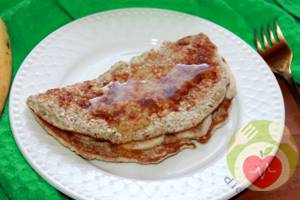
To prepare you will need:
- 150 g oat flour or crushed flakes;
- 150 g buckwheat flour;
- 100 ml milk, low-fat kefir or water;
- 1 chicken egg;
- sugar and salt (to taste);
- 150 g of any berries or fruits;
- vegetable oil.
- Mix the liquid with sugar, salt, buckwheat and oatmeal. Add vegetable oil.
- Chop the fruit and add to the batter.
- Prepare a baking sheet - cover with parchment or sprinkle with vegetable oil.
- Pour some of the dough onto a baking sheet and place in a preheated oven.
- Cook for about 5 minutes in an oven preheated to 180 degrees.
- Serve warm, adding low-fat sour cream or jam.
Dessert of cottage cheese and fruits
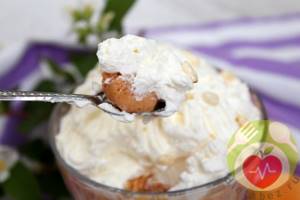
To prepare you will need:
- 500 g low-fat cottage cheese;
- 300 g low-fat sour cream;
- 30 g agar-agar or gelatin;
- various fruits and berries - kiwi, banana, strawberries, apples (to taste);
- vanilla, natural honey or sugar (to taste).
Preparation:
- Prepare according to the instructions on the agar-agar/gelatin package.
- Mix cottage cheese, sour cream and honey/sugar in a container.
- Add gelatin or agar-agar to the curd mass. To stir thoroughly.
- Prepare a mold with high sides and cover it with cling film.
- Pour in the mixture and refrigerate for at least 3 hours.
- You can decorate the finished dish with berries. Serve, cut into portions.
Why do you need to diet?
In case of exacerbation of gastritis or its chronic form, none of the drugs presented by pharmaceuticals can alone help in the fight against the disease. Medicines, even the most expensive ones, can only relieve the main symptoms of the disease. Lack of restrictions and uncontrolled eating can again cause manifestations of gastritis.
For complete and effective therapy, a set of measures is required, including mandatory adherence to a special diet. This is the only way for a patient to achieve remission with existing chronic gastritis and make their life easier.
Possible consequences of not following the diet
Refusal of the gastroenterologist’s recommendations in terms of nutrition, both in chronic gastritis and in case of exacerbation of the disease, can lead to the following problems:
- vitamin deficiency;
- dysfunction of the stomach and other digestive organs;
- weight loss due to the development of fear before eating;
- ulcer and its consequences, including bleeding in the stomach;
- stomach cancer due to lack of treatment for gastritis.
Products allowed by diet
For chronic gastritis or its exacerbation, you can consume the following products and products:
- Dried or stale bread made yesterday, dry biscuits or crackers. Biscuit allowed.
- Pureed soups with the addition of cereals and pasta products. The broth can be cooked with lean meat or fish. Vegetable or mushroom soups are preferred.
- Meat and fish can be baked, the main thing is to prevent the formation of a crust, steam or boil. It is important to use low-fat varieties during the cooking process.
- Vegetables should be served boiled, steamed or stewed; it is advisable to chop them as much as possible before eating.
- To improve the taste of dishes, you can use bay leaves, as well as spices such as cinnamon and vanilla.
- The list of permitted dairy products includes kefir and yogurt. You can use non-sour and pureed cottage cheese. Mild cheese should be chopped before eating.
- The best porridges are buckwheat, oatmeal, rice, pearl barley and millet. During cooking, you can add a small amount of milk.
- Sweets allowed for chronic gastritis and exacerbation of the disease are marshmallows, berry or fruit jam, honey, sugar and pure marmalade.
- As drinks, it is better to use decoctions of mint, rose hips, cranberries, chamomile and green tea. Sometimes you can allow coffee and cocoa with the addition of a few spoons of milk.
The food system provided by “Table No. 2”
The diet is prescribed for patients with the gastrointestinal tract, for infectious diseases, for inflammation of organs, and in the postoperative period.
Diet 1a, unlike 2 for gastritis, has a sparing menu. A similar diet for exacerbation of gastritis and ulcers includes crushed foods.
The purpose of diet 2 for gastritis is to restore secretory function and normalize peristalsis.
Distinctive feature of tables 1 and 2
The second table combines good nutrition and gentle treatment. The balance of fats and proteins is up to 100 g, carbohydrates - up to 420 g. The calorie content of the dishes does not exceed 300 kcal.
Diet 1a for gastritis involves eating food in crushed form. Diet 2 does not exclude fried foods, without the use of breadcrumbs. Fried foods do not need to be cooked daily. It is allowed to diversify the menu, but preference is better given to dishes that are boiled or steamed. Foods with a lot of fiber need to be pureed. Eating too cold or hot food is strictly prohibited.
More information about dietary restrictions:
- Bread - yesterday's baked wheat flour.
- For meat, give preference to tender varieties - veal, rabbit meat. The varieties are prepared in pieces, after removing the skin and tendons. Fillet, lean pork, and beef can be processed into minced meat to facilitate digestion.
- It is permissible to fry lean varieties of fish, not deep-fry.
- Soft-boiled eggs are allowed. It is better to consult your doctor before eating hard-boiled eggs.
- All dairy products are allowed.
- Soups are prepared using “moderate strength” broths.
- Cereals are cooked in water, broth, and milk. In individual cases, the use of crumbly cereals is allowed.
- Vegetables filled with fiber are crushed using a blender. The method of preparing vegetables is boiling, stewing, baking. The following are considered especially useful: potatoes, pumpkin, carrots, fresh herbs. But greens should be chopped well before use.
- Bananas and pears are valuable fruits for the table. It is better to grate the remaining fruits and berries. It is better to bake apples in the oven or prepare compote.
- For desserts, marmalade, mousses, honey, jellies, preserves and jams are suitable.
- The second table allows the consumption of various drinks, except carbonated ones.
Prohibited foods include smoked meats, fresh baked goods, pearl barley and millet porridge, and legumes.
Mustard and horseradish, fatty sauces should be excluded from the diet. It is better to avoid animal fats. It is also better to avoid berries that have a rough peel, for example, gooseberries.
Salad made from chopped fruits can injure the mucous membranes. But a salad of baked apples with honey will do you good. Spicy cheese will be harmful to health; you will need to replace it with soft cream cheese, which can be easily spread on bread.
Types of diets
If acidity is reduced, gentle and stimulating diets are used. Nutrition systems solve specific problems associated with increasing acidity. The best option is when the menu is developed by a nutritionist or gastroenterologist.
Gentle
If inflammation in the digestive organ is in the active phase, gentle nutrition is prescribed. The main task is to create conditions that contribute to the normalization of the gastrointestinal tract and the elimination of the inflammatory process. For this purpose, foods that contribute to thermal, mechanical and chemical irritation of the walls of the digestive organ are excluded from the menu. Main principles:
- food should be warm, boiled, well ground,
- fried and overly baked (with crust) - prohibited,
- preference for cereal decoctions, jelly, soft-boiled eggs, mashed potatoes, jelly desserts are favored,
- Anything rich in fiber is prohibited (it injures the mucous membrane); with hard connective tissue (cartilage, fat); garlic, onions, meat and fish broths,
- exclusion of pickles, alcohol.
The gentle diet lasts a week.
Stimulating
As the inflammation subsides, nutrition is introduced to stimulate stomach activity. With such a diet, food is necessarily crushed (cut/shredded). Food is consumed every 2-3 hours. Gradually, foods that promote the secretion of hydrochloric acid are introduced into the diet. This includes parsley, carrots, raspberries, some citrus fruits (lemons, oranges) and crackers. The consumption of fermented milk and milk is acceptable, but baked goods, fried foods, plant foods with fiber, canned food and spices are strictly prohibited. Alcohol and tobacco products are strictly taboo. The duration of restrictions is determined by the patient's condition.
Allowed and increasing stomach acidity
Following a diet does not mean giving up delicious food. The list of what is allowed is actually long. If you learn to combine these ingredients correctly, you can diversify your menu with not only healthy, but also very tasty dishes.
- cereal/vegetable soups;
- boiled chicken/rabbit;
- lean fish;
- mild cheese;
- scrambled eggs);
- omelettes;
- porridge;
- yesterday's bread;
- vegetables (pumpkin, potatoes, carrots), greens;
- uncool tea.
Juice products are also allowed; they are introduced into the diet after the symptoms of exacerbation have stopped. These include:
- apples;
- sour milk and milk;
- fresh juices;
- raspberries, cherries, cranberries;
- citrus fruits (lemons, oranges, but in limited quantities).
In the absence of an exacerbation, patients are sometimes allowed to drink a little weak coffee. Kumys, wheat (its sprouted grains), and birch sap increase the secretion of juice.
Important! Juice foods (which increase acidity) are introduced into the diet gradually, one at a time, to assess how the body reacts to them. If there are no symptoms of deterioration, the following product is introduced.
Diet planning for gastritis
Lactic acid products help digestion
When drawing up a diet for people with gastritis, they take into account, first of all, how various foods affect the stomach’s secretion of hydrochloric acid, gastric juice and the motor-evacuation function of the stomach, as well as pepsin, the motor-evacuation function of the stomach. List of causative agents of gastric secretion:
- A decoction of mushrooms or vegetables, fish or meat broths (they are rich in extractive substances).
- Absolutely all fried foods.
- Stewed meat or fish.
- Mushroom, meat, tomato or fish sauces.
- Salted or smoked foods.
- Pickles, pickled or pickled fruits and vegetables.
- Canned fish, meat or vegetables.
- The eggs are hard-boiled, especially the yolk.
- Baking or rye bread.
- Unripe or sour berries and fruits.
- Seasonings, spices, spicy vegetables.
- Fermented milk products with increased acidity, whey and skim milk.
- Overheated or stale vegetable fats.
- Coffee, especially strong.
- Absolutely all carbonated drinks.
- Alcoholic drinks.
The diet should consist of different foods
All of the above products are contraindicated for gastritis, and it is strongly recommended not to consume them at least during an exacerbation, but it is better to generally limit them in your diet. And now a list of foods that do not stimulate gastric secretion:
- Slimy soups on cereals
- Milk soups containing pureed cereals.
- Vegetable soups with a weak broth.
- Boiled fish, boiled pureed or minced meat.
- Puree of boiled vegetables.
- Soft-boiled eggs, steamed omelettes, beaten egg whites.
- Whole cream or milk.
- Fresh cottage cheese, preferably unleavened or calcined.
- Liquid porridge with milk.
- Wheat bread, but only from premium flour, 1st grade.
- Purees, mousses, jelly or jelly from non-acidic berries or fruits.
- Still mineral water
- Tea, always weak, is better with milk.
- Vegetable oils in their natural form.
It is known that mushy or liquid foods are digested faster and easier.
Such products irritate the intestinal lining less, and, what is important for gastritis, the gastric mucosa. All of the above products are classified as such products
There should be first courses every day!
Solid food, firstly, is digested more slowly, and secondly, irritates the gastric mucosa. Also, fried or crusted dishes also have a mechanical effect on the lining of the digestive tract, which is absolutely not necessary for a person suffering from gastritis. Therefore, you should eat food that is steamed or boiled in water.
Also, the stomach is greatly irritated by foods high in coarse fiber; such foods have a lot of dietary fiber. Foods contraindicated for gastritis also include foods with a large amount of connective tissue. In order for food to be digested more easily and quickly, the temperature of the food taken should be almost equal to the temperature of the stomach itself, namely 37 degrees.
Dishes and drinks at temperatures above 60 degrees, on the contrary, irritate the gastric mucosa. Also, food with a temperature of less than 15 degrees also slows down digestion and the removal of digested food from the body. For gastritis, the doctor will prescribe you fractional meals, which means often, in small portions, because a large amount of food has a bad effect on the functioning of the digestive system, and especially the stomach.
Therefore, for all diseases associated with the stomach or intestines, you need to eat about 5-6 times a day. In addition, the total amount of food per day should be reduced by about a kilogram. When following a diet, you must take into account exactly what diagnosis your doctor gave you, because there are quite a few classifications of gastritis, and each person has his own symptoms and characteristics.
It is also worth considering the stage, phase and severity of the disease. For example, nutrition during an exacerbation will be very different from nutrition during remission. Chronic gastritis differs from acute gastritis and does not require a strict diet, but only a healthy balanced diet and adherence to a regimen.
Types of gastritis
It is not enough to simply identify the presence of gastritis with low acidity; the doctor can prescribe treatment only after determining the type of the disease:
- Atrophic is characterized by thinning of the mucous membranes of the stomach, tissue death, and loss of their protective functions. If the level of acid in the stomach decreases significantly, then this condition will lead to the development of cancer. It is impossible to establish the exact cause of the development of such a pathology, but experts are inclined to believe that poor nutrition, overeating and uncontrolled use of antibiotics and hormonal drugs are to blame.
- Chronic is divided into several stages - decompensation, partial compensation and compensation. This type of disease develops slowly: first, the level of acid in the stomach increases. If left untreated, the cells responsible for producing acid begin to die. As a result, the acid level is normalized. The progression of the pathology leads to the death of the mucous membrane and the development of a chronic version of the disease.
Prohibited items and products for gastritis
Chronic gastritis and its exacerbation prohibit the consumption of many foods that can cause irritation of the gastric mucosa.
Such products include:
- Milk soups, okroshka, broths with the addition of legumes.
- Freshly baked products made from flour and pastry.
- Corn in its pure form and dishes with the addition of this grain.
- Smoked, marinated and salted products.
- Ungrated vegetables. The exception is tomatoes; they can be eaten without chopping.
- Mustard, horseradish, hot spices.
- Grape juice and kvass.
- Chocolate and any ice cream.


